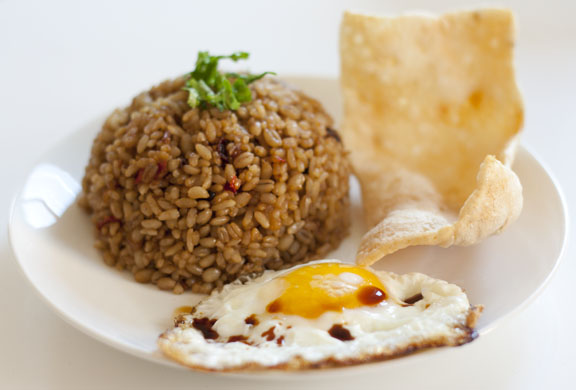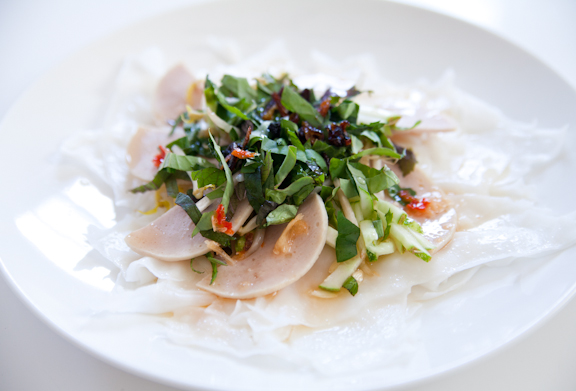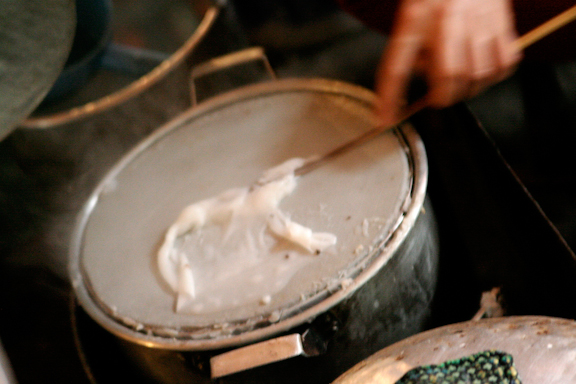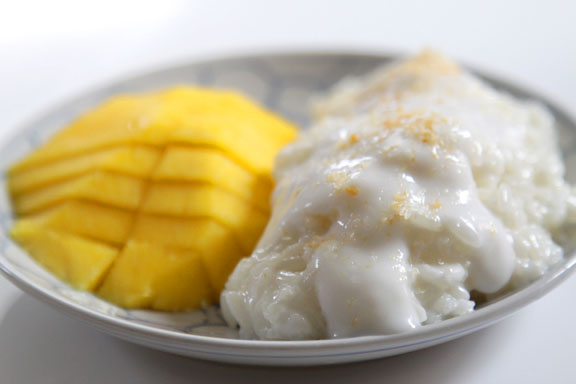Nasi goreng, which means “fried rice†in Indonesian or Malay, is one of the dishes I was excited about when I visited Malaysia last year. I know — how exciting could fried rice be, right? But when I looked at James Oseland’s recipe in Cradle of Flavor and saw that it involved belacan (shrimp paste), I immediately knew I needed to try it. Unfortunately, when I got to Malaysia, the versions I got turned out to be simple fried rice with soy sauce. Nevertheless, I still like the James Oseland recipe, which is the classic Javanese version he learned from the Indonesian family he stayed with when he visited as a teenager. I will take any excuse to add shrimp paste to a dish. Plus, “nasi goreng†is just so much fun to say. :)
Nasi Goreng (Javanese Fried Rice)
Adapted from James Oseland’s Cradle of Flavor
Serves 2-3
The original recipe was a bit too sweet for me, so I modified it a little by toning down the palm sugar and kecap manis (Indonesian soy sauce that is a bit like molasses) and then upping the shrimp paste. :) I used the clay-like dried belacan I brought back from Malaysia, but you can substitute store-bought jarred shrimp paste, which is wet and I think more salty, so you might add less and adjust to taste. I also am too lazy to roast the shrimp paste in foil over the open flame of a burner, so I just dry toast it in the frying pan before I add the rest of the ingredients.
Be sure to use day-old rice when making fried rice of any kind. Freshly cooked rice is too soft and will clump and stick when fried.
Flavoring paste:
1 shallot, chopped
1 clove garlic
1 tsp palm sugar (or dark brown sugar)
1-2 Thai bird chilies
2 tsp belacan (dried shrimp paste)
2 Tbsp vegetable or canola oil
3 cups day-old jasmine rice (I used brown rice in the photo)
1 tsp kecap manis (Indonesian sweet soy sauce)
Shrimp chips (optional)
2-3 eggs (1 per serving)
Kosher salt
1. If using the shrimp chips, fry them now and set aside. (See directions here for frying shrimp chips. You can also make it in the microwave, but the texture tends to be chewier that way.)
2. Heat a dry skillet over medium to medium-high heat. Dry toast the belacan until aromatic and the edges are a bit brown. Remove from heat.
3. Chop the shallot, garlic, and chilies. Pound these, along with the palm sugar and toasted belacan, with a mortar and pestle to release the juices and flavors. Grind until the mixture forms a paste.
4. Heat the oil in a skillet over medium-high heat. Add the paste and stir until the paste separates from the oil. Allow the garlic and shallot to cook but not brown. Using your fingers, break up the day-old rice and add to the pan. Stir the rice so that it gets coated in the oil and flavoring paste. Be sure to break up any clumps still left in the rice.
5. Add the Indonesian sweet soy sauce and stir to combine. Taste and add salt if needed.
6. In another skillet, fry each egg sunny side up until the white is set but the yolk is still a bit runny. (The original recipe calls for the yolk to be set too, but I prefer it runny.)
7. To plate, fill rice bowls with the rice, press to set, and then overturn the bowl onto a plate. Remove the bowl. Place a shrimp chip and a fried egg alongside the rice. If you like, you can also serve slices of cucumber and tomato with the rice.















Connect with us